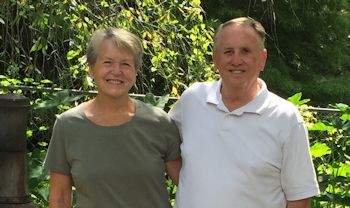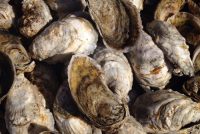JACKSONVILLE – For Jim and Bonnie Swartzenberg, the path to environmental activism began with an island.
During the early 1980s, when the couple’s relationship blossomed from a blind date to marriage, Permuda Island was being eyed for development.
Supporter Spotlight
The small, narrow island is nestled in Stump Sound where Bonnie Swartzenberg’s parents in Tar Landing cultivated their Onslow County land along the Intracoastal Waterway in the summers and farmed the sound’s waters in the winters.
Bonnie Swartzenberg’s parents, Bill and Bernice Rice, feared that Stump Sound, teeming with oysters, shrimp and crab, could be contaminated or killed by stormwater and other the byproducts of development.
The Rice’s joined forces with a neighbor, Lena Ritter; a fledging N.C. Coastal Federation; and other locals to eventually persuade the state to buy and preserve Permuda Island. Today, it’s known as the Permuda Island Reserve, a rich, scenic land between Topsail Island and the mainland.

The Rice’s fight to keep the island undeveloped left a lasting impression on their daughter and son-in-law, to whom they passed on the torch to advocate for, and contributing to, water quality restoration and improving oyster habitat.
The Swartzenbergs’ are among the recipients of this year’s Pelican Awards, an annual accolade given by the federation in recognition of the work people, businesses, nonprofit groups, educators and local and state governments have done to improve environmental quality on the coast.
Supporter Spotlight
During the 20 years the couple owned and operated an oyster aquaculture business, Jim Swartzenberg served on a number commissions and advisory committees aimed at protecting and restoring oyster habitat. He’s a former president of the N.C. Shellfish Growers Association, a former chair of N.C. Sea Grant and he served on the Joint Legislative Commission on Seafood and Aquaculture.
He advocated for the research hatchery at the University of North Carolina at Wilmington and was instrumental in a lawsuit that championed shellfish waters.
The Swartzenbergs helped introduce oyster aquaculture – growing oysters in floating cages – to North Carolina. For years, they’ve aided the federation in educating state legislators and the general public about stormwater management and fought to strengthen stormwater rules.
“It’s just putting a voice out there and making sure you’re being heard,” Jim said.
Sitting at a patio table on the couple’s sunroom in their downtown Jacksonville home, he credited his in-laws as truly deserving of the award.
Growing up in mid-state New York, Jim’s only exposure to oysters was the oyster stew his mother cooked once a year. He wasn’t fond of the “little ugly things.”
He was a Marine Corps officer stationed at Camp Lejeune when he asked Bonnie on a second date in 1981. The pair spent the evening on the Rice’s farm scraping for clams, something Bonnie enjoyed doing growing up on the banks of the sound.
On that same date, Jim partook in the family’s oyster roast. The naturally salted, plump oysters from Stump Sound were much tastier than the canned oysters his mother put in her stew. Before long, he was hooked.

“They were good oysters,” he said.
He retired from the Marine Corps in 1983 after 22 years and two tours in Vietnam. By the mid-1990s the couple decided to take the plunge and do something they had been talking about for years. They opened an oyster aquaculture business.
For the next 20 years the Swartzenbergs cultured and harvested oysters in more than 30 acres of state-leased waters in Stump Sound.
It was hard work. The yield from harvest to harvest was unpredictable. And, it was evident that oysters were not flourishing in Stump Sound as they did when Bonnie was a child.
The abundance of oysters in Stump Sound has dwindled over the years, mirroring the vast depletion of oyster habitat on the East Coast.
Bonnie fondly recalls her girlhood when she would cull oysters her mother would load onto their family’s boat.
“In my lifetime I have seen a tremendous change,” she said. “There were so many oysters it was like we didn’t know what to pick. We would get 12 to 15 bushels in one morning.”
By the time she and her husband opened their business, things were different in the sound.
“You’d have a good year one year and the next we wouldn’t find anything,” she said. “We’d plant the bottom. They wouldn’t grow anymore. It just became harder and harder.”
The Swartzenbergs used shell bags, a culturing method where oyster shells and limestone marl are packed into mesh bags used to build new oyster reef.
“You couldn’t rely on mother nature,” he said. “You had to manipulate it somehow. There’s something different about that sound from what it was 30 years ago. Now it’s really hard even to grow aquaculture oysters.”
In December of last year, they closed J&B Aquafood and sold a majority of their leases to a Wilmington-based seafood company.
Since the death of Bonnie Swartzenberg’s mother last year, the couple has been transitioning from the sound to the land.
They’ve taken up gardening.
“I don’t think we’re done yet,” Bonnie said. “It’s just too much a part of us. We’ll get back and be active. We might even fill some shell bags.”








